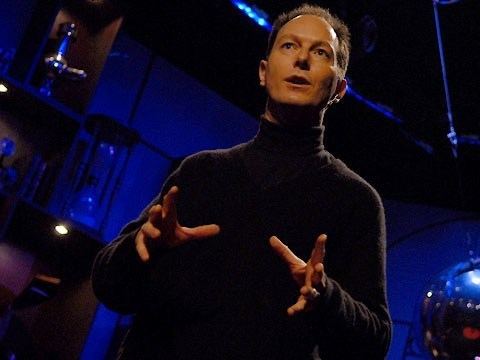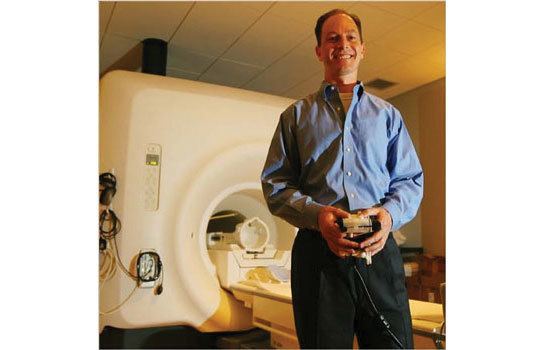Name Christopher deCharms | Organizations founded Omneuron | |
 | ||
Christopher decharms a look inside the brain in real time
Christopher deCharms is a serial entrepreneur, neuroscientist, social entrepreneur, author, inventor, and founder and CEO of Omneuron, a life sciences company focusing on new technologies for measuring and changing brain function based on pioneering imaging methods that allow people to watch the activation of their own brains 'live' using functional magnetic resonance imaging (fMRI). This allows people to learn to change the patterns of their own mind and mental functioning through changing their brain activation patterns. This work, funded by the National Institutes of Health, is in late-stage clinical trials for novel treatments of chronic pain, depression, and anxiety. Recently deCharms has founded Brainful Inc to provide the Omneuron technologies to people worldwide by mobile/web for the treatment of chronic pain, presented in 2014 at LeWeb. deCharms is also founding president of Civizen Inc. which is developing a new technology to stop violence and promote safety.
Contents
- Christopher decharms a look inside the brain in real time
- Christopher decharms the future of the mind leweb 14 paris
- Neuroscience
- rtfMRI training
- Selected research papers
- References

Christopher decharms the future of the mind leweb 14 paris
Neuroscience

DeCharms has developed a set of technologies allowing patients, physicians, researchers, and subjects to visualize and control the functioning of the brain using non-invasive methods based on real-time functional magnetic resonance imaging (rtfMRI), see deCharms' TED talk, and is exploring applications of functional brain imaging. DeCharms started his research career in neurophysiology as a graduate student and later postdoctoral researcher in the laboratory of Professor Michael Merzenich at the UCSF Keck Center for Integrative Neuroscience. This work included recording patterns of brain activation from multiple locations in the brain, and how these patterns of activation underlie perception, experience and learning.
rtfMRI training

DeCharms and a team of collaborative researchers have explored whether people can learn to control patterns of activation taking place inside their own brains. It had not previously been possible to non-invasively measure brain activation in real time using neuroimaging, but recent advances in computation and neuroimaging have made this a reality using rtfMRI. Subjects' brain activation patterns are measured using real time fMRI as the subjects watch from inside the scanner using virtual reality goggles, and subjects are trained to control the patterns of activation inside their own brain. This in turn leads to changes in the subjects' mental experiences. For example, subjects have learned to control activation in brain regions associated with pain, and they report a corresponding decrease in their levels of pain. DeCharms' team coined the term Neuroimaging Therapy, in use to describe this approach. Research on rtfMRI-based training has been published in the scientific literature and has also been broadly covered in the popular press including The New York Times, BBC, NPR, Wired, Technology Review. This research has been conducted at Stanford University and more recently at Omneuron's 3T MRI Research Center in Menlo Park, California through funding from the National Institutes of Health.
Selected research papers

- deCharms, R. C.; Maeda, F.; Glover, G. H.; Ludlow, D.; Pauly, J. M.; Soneji, D.; Gabrieli, J. D. & Mackey, S. C. (2005). "Control over brain activation and pain learned by using real-time functional MRI". Proceedings of the National Academy of Sciences USA. 102 (51): 18626–18631. Bibcode:2005PNAS..10218626D. PMC 1311906 . PMID 16352728. doi:10.1073/pnas.0505210102.
- deCharms, R. C.; Christoff, K.; Glover, G. H.; Pauly, J. M.; Whitfield, S. & Gabrieli, J. D. (2004). "Learned regulation of spatially localized brain activation using real-time fMRI". NeuroImage. 21 (1): 436–443. PMID 14741680. doi:10.1016/j.neuroimage.2003.08.041.
- Miller, K. L.; Hargreaves, B. A.; Lee, J.; Ress, D.; deCharms, R. C. & Pauly, J. M. (2003). "Functional brain imaging using a blood oxygenation sensitive steady state". Magnetic Resonance in Medicine. 50 (4): 675–683. PMID 14523951. doi:10.1002/mrm.10602.
- deCharms, R. C. & Zador, A. (2000). "Neural representation and the cortical code". Annual Review of Neuroscience. 23: 613–647. PMID 10845077. doi:10.1146/annurev.neuro.23.1.613.
- deCharms, R. C (1998). "Information coding in the cortex by independent or coordinated populations". Proceedings of the National Academy of Sciences USA. 95 (26): 15166–15168. Bibcode:1998PNAS...9515166D. PMC 33931 . PMID 9860939. doi:10.1073/pnas.95.26.15166.
- deCharms, R. C.; Blake, D. T. & Merzenich, M. M. (1998). "Optimizing sound features for cortical neurons". Science. 280 (5368): 1439–1443. PMID 9603734. doi:10.1126/science.280.5368.1439.
- deCharms, R. C.; Merzenich, M. M. (1996). "Primary cortical representation of sounds by the coordination of action-potential timing". Nature. 381 (6583): 610–613. Bibcode:1996Natur.381..610D. PMID 8637597. doi:10.1038/381610a0.
